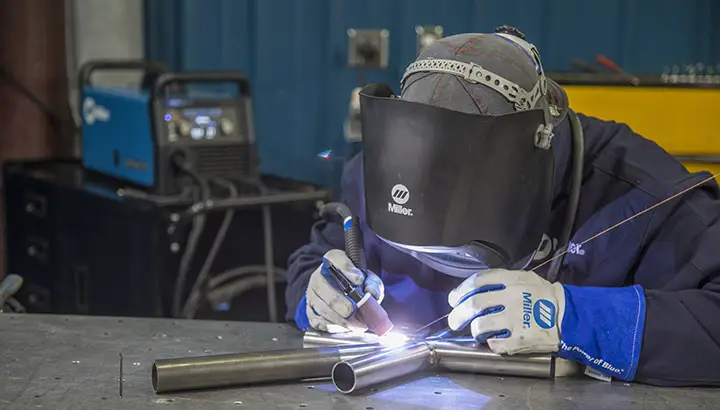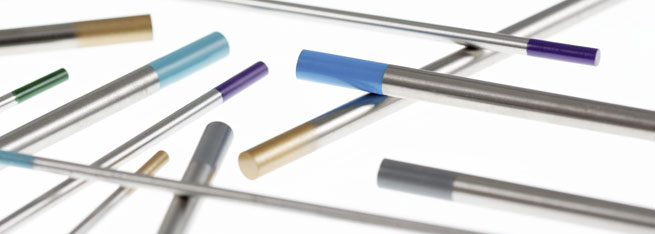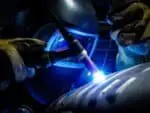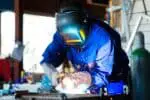TIG Welding (GTAW) is a method that produces a weld with or without filler material by using a non-consumable tungsten electrode.
Welders employ this process with shielding gas and filler metals, which may or may not be used. Welding current, travel speed, arc voltage or arc length, and shielding gas composition are some of the key factors in TIG welding.
Since the arc is produced between the end of a small diameter tungsten electrode and the workpiece in TIG welding, you will need a power supply, a torch, an electrode of your choosing and protective equipment.
Power Supply- TIG welding power sources can be either DC or AC.
TIG welding with DC is utilised for mild steel/stainless steel, whereas AC welding is used for aluminum. Based on the kind of connection, the TIG welding method offers three welding current possibilities. Each connecting technique has advantages and disadvantages.
TIG torch- Depending on the application, welding torch designs vary greatly. Foot controls are frequently favoured over designs that have an on/off switch and a current control in the handle.
There are two types of TIG torches-
1.) TIG Torches with Air Cooling
Air cooled TIG torches feature a single hose input for gas. As a result, Argon or Helium shields your weld puddle from external impurities while simultaneously cooling the torch with its airflow.
2.) TIG Torches with Water Cooling
Water cooled TIG torches offer a benefit over air cooled torches in that they do not overheat as quickly. They are capable of handling extremely high amperages, followed by a quick cooling procedure.
Professional TIG welders and fabricators prefer water-cooled torches.
Electrodes- For hand welding, regardless of electrode diameter, the electrode tip is typically honed to an angle of 60 to 90 degrees.
Because the tip angle dictates the form of the arc and affects the penetration profile of the weld pool in mechanised applications, consistency in grinding the tip and verifying its condition between welds is essential.
Electrodes must be sized and shaped before they can be utilised for TIG welding.
Some TIG welding applications require a special form electrode, which is utilised for important welds.
Contaminated electrodes or those that are too lengthy to fit inside the electrode cap must be trimmed.
See also: What Rod do You Use to TIG Weld Copper?
Protective gears- Safety goggles, jackets, overalls, gloves and helmets are essential for your safety while welding.
Welding jackets are made of the same materials as welding gloves. Another important thing you will require for your safety while welding are TIG goggles.
These are inexpensive and are useful for your welding projects.
Why do you require a TIG welder?
1.) A TIG welder may be required if you need to weld paper thin metals at extremely low amperage levels.
2.) A TIG welder may be required if an aesthetically appealing weld is required for highly visible portions.
3.) A TIG welder may be required if exceedingly high-quality welds are required.
4.) A TIG welder may be required for constructing a race car or truck chassis out of chrome-moly tubing.
5.) A TIG welder may be required if you weld a lot of non-ferrous metals such as magnesium, copper, and aluminum.
When it comes to TIG welding, you’ll need more than a few pieces of equipment and a proper PPE to keep yourself safe. Here are other things you’ll need:
-
-
- Auto-darkening helmet.
- Sander/grinder/rods
- Welder.
- Shielding gas
- Tungsten.
-
Let us get into it in detail:
Auto-Darkening helmet- You must wear a welding helmet at all times.
When it comes to welding helmets, you have two options, auto-darkening or manual darkening.
If you’re making welds that need to appear good and you really care about your comfort while working, then auto-darkening ones are a must-have.
However, a standard welding helmet will cost you between $20 and $100, depending on the quality and brand.
Sander/grinder/rods- Grinding wheel is used for sharpening your tungsten carbide.
Sharp tungsten is required for it to operate well and you may buy a tungsten grinder alone or a bench grinder that also contains a sander.
You must determine the filler metal rod you will require based on the size of the metal you will be utilising. The size of these varies.
Watch this video for a detailed information on what should you sharpen your tungsten-
Welder- The most critical piece of equipment in your welding arsenal is the welder. If you wish to undertake multiple welding operations, you should acquire the 3 in 1 welder and a machine from a good, reputed brand.
Miller is a brand that makes one of the best welding machines in the market. You can go for this Miller Electric TIG Welder. If you want a machine that can handle everything, you should look into this one.
This welder is the most flexible and versatile. The main reason for this is that it is a Multimatic welder that supports MIG, TIG, and stick welding.
Because this is a very high-end Miller welder, you also receive a plethora of accessories along with it.
Check it out here-
- Product Type: Electronic Component
- Package Quantity: 1
- Package Weight: 62.35 lbs
- Country Of Origin: United States
Prices pulled from the Amazon Product Advertising API on:
Product prices and availability are accurate as of the date/time indicated and are subject to change. Any price and availability information displayed on [relevant Amazon Site(s), as applicable] at the time of purchase will apply to the purchase of this product.
Shielding gas- When using TIG welders, you must have a gas tank to connect to. Shielding gas is absolutely necessary for TIG welding as it will shield your weld pool from corrosion or oxidation.
And in this sort of welding, the most usually employed shield gas is argon. Argon gas offers more control and operates at lower temperatures, making it ideal for thinner metal welding.
Here are few advantages of argon for TIG welding-
-
-
- It’s less expensive than helium.
- Arc stability is excellent.
- Excellent cleaning action.
- Arc voltages are reduced.
-
TIG welding procedure
1.) Select Your Electrode
Always use an electrode that is appropriate for the metals being welded. A pure tungsten rod is the ideal rod to use for welding aluminium.
2.) Set up the Rod to be Used
Grinding the rod to the appropriate point of use is part of the preparation process. Grinding the rod is frequently necessary, especially if it is fresh, has a rounded tip, or is not pointed. Grinding will lower the amount of energy consumed during welding.
3.) Insert the Electrode into the Collet
This procedure entails unscrewing the electrode holder, inserting your electrode, and then screwing it back in place. If your electrode is already inside, you may skip this step.
4.) Choose the TIG Welding Settings
Welders can choose between three settings on a TIG welding machine: AC or DC. When welding metals like aluminum, alternating current (AC) settings are optimum.
When it comes to balling your tip or stick or working with steel metal, welding Direct Current is the best option.
Then you have the cleaning/penetrating setting, which will position it on the sharp end.
5.) Prepare the Shielding Gas
When welding aluminum metals, use pure argon, while when welding steel, use a combination of argon and carbon dioxide.
6.) Prepare Your Metal and Welding Table
To allow enough energy to flow through the metal, you’ll need a huge metallic surface. A huge, flat sheet of metal can also be used in place of a welding table.
Remove dust and other contaminants from the surfaces by scrubbing them with a wire. Cleaning guarantees that your welds are more attractive and exact. Wipe off the welding rods with acetone.
To hold the welds in place, clamp the metals before starting the welding process. Most welders also choose to spray anti-spatter on the welding table to prevent metal leaks from clinging to the welds.
7.) Getting Ready
Protecting yourself from radiation, heat, sunburns, and toxic gases created during welding need protective clothing. Welders must wear thick gloves, a welding helmet, close-toed shoes, and a welding coat.
8.) Carry out the Final Inspection
At this point, you must double-check that all equipment is in place and working properly. Check to see if your equipment is well worn and tucked up as indicated in a welder’s instruction.
Continue by placing the electrode in your dominant hand and testing it. Before you begin welding, make sure the electrode moves easily and is simple to deal with during testing.
Conclusion
TIG welding is used for creative welding as well as welding that people find aesthetically pleasing. It is suitable for stainless steel and aluminum.
TIG welding is not difficult if you have all of the necessary equipment and follow all of the processes correctly.









